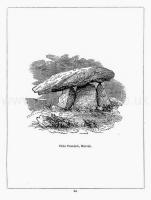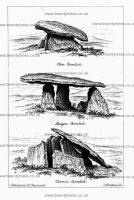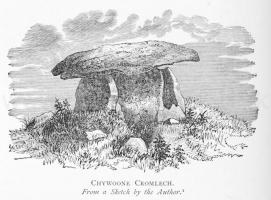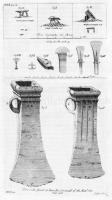Text this colour links to Pages. Text this colour links to Family Trees. Text this colour are links that are disabled for Guests.
Place the mouse over images to see a larger image. Click on paintings to see the painter's Biography Page. Mouse over links for a preview. Move the mouse off the painting or link to close the popup.
Chûn Quoit is in Chûn, Cornwall, South-West England Burial Mounds.

Celtic, Druidical and Roman Remains. The top-stone of Chûn cromlech [Map] is nearly 13 feet long and 11½ feet wide, — its elevation is about 4 feet.
Archaeologia Cambrensis 1857 Chapter 4. III.—The most perfect of all our cromlechs is that of Ch'ûn [Map], very nearly 5 miles west-north-west of Penzance, and 500 yards west of Ch'ûn Castle; the castle being partly in Madron, and partly in Morvah; the cromlech partly in St. Just, and partly in Morvah. The top stone is 12¾ feet long, 11½ wide, and 35¾ in circumference. The two side supporters are each about 8 feet in length, and, with the two end stones, form "a pretty regular kist-vaen,"" which, in Borlase's time, had a "low barrow, or heap of stones round it," much of which still remains; so that the supporters, although between 5 and 6 feet high, rise only four feet above the barrow. A correct sketch of this is fig. 1 of plate II.

Archaeologia Cambrensis 1857 Chapter 4. Chûn Quoit [Map], Lanyon Quoit [Map] and Zennor Quoit [Map].

Nænia Cornubiæ by William Borlase Chywooner Cromlech. Chywoone Cromlech [Map].
The most perfect and compact Cromlech in Cornwall is now to be described. It is situated on the high ground that extends in a northerly and westerly direction from the remarkable megalithic fortification of Chywoone or Chuun, in the parish of Morvah. The "Quoit" itself, which, seen from a distance, looks much like a mushroom, is distant just 260 paces from the gateway of the castle; and about the same distance on the other side of it, in the tenemerit of Keigwin, is a barrow containing a deep oblong Kist-Vaen, long since rifled, and now buried in furze. Thinking this monument the most worthy of a careful investigation of all the Cromlechs in the neighbourhood, the author proceeded to explore it in the summer of 1871, with a view to determine, if possible, the method and means of erection in the case of such structures in general.
Note 1. Footnote on image. There is a dolmen at Moytura, in Ireland, and another at Halskov, in Scandinavia, the drawings of which would both pass for Chywoone Cromlech.
The Antiquities of Cornwall by William Borlase Chapter IX. In several parts of Cornwall we find a large flat Stone in a horizontal position (or near it) supported by other flat Stones fix'd on their edges, and fasten'd in the ground, on purpose to bear the weight of that Stone, which rests upon, and over-shadows them, and by reason of it's extended surface, and it's elevation of fix or eight feet, or more, from the ground makes the principal figure in this kind of Monument. The situation which is generally chosen for this Monument is the very summit of the hill, and nothing can be more exact than the placing some of them, which shews, that those who erected them were very sollicitous to place 'em as conspicuously as possible. Sometimes this flat Stone, and it's supporters, stand upon the plain natural soil, and common level of the ground; but at other times it is mounted on a Barrow made either of Stone or Earth; it is sometimes plac'd in the middle of a Circle of Stones-erect, and when it has a place of that dignity, must be suppos'd to be erected on some extraordinary occasion; but when a Circle has a tall Stone in the middle, it seems to have been unlawful to remove that middle Stone, and therefore we find this Monument of which we are speaking sometimes plac'd on the edge of a Circlec. But we find fome Cromlêhs erected on such rocky situations, and so distant from houses, (where no Stones-erect do stand, or appear to have flood,) that we may conclude, they were often erected in places where there were no such Circles. Some of these Monuments are quite inclos'd, and buried, as it were, in the Barrow; As that of Senor [Map] in Cornwall (Plate XVIII. Fig. iii.) and that at Chûn [Map] (Plate XX. Fig. x.) and that mention'd by Wormius, pag. 4. Mon. Dan.d
Note c. Sec Pl. XIII. Fig. iii. a, and b, in Boscawen-ûn [Map] from which we may draw this Consequence; that the Cromlêhs was posteriour in date to the Circle, and the former erected there for the sake of the latter.
Note d. One only which I have yet heard of, has it's Supporters, or Side-Stones, fix'd on a solid Rock. State of Downe, pag. 199.


![]() Become a Member via our Buy Me a Coffee page to read complete text.
Become a Member via our Buy Me a Coffee page to read complete text.